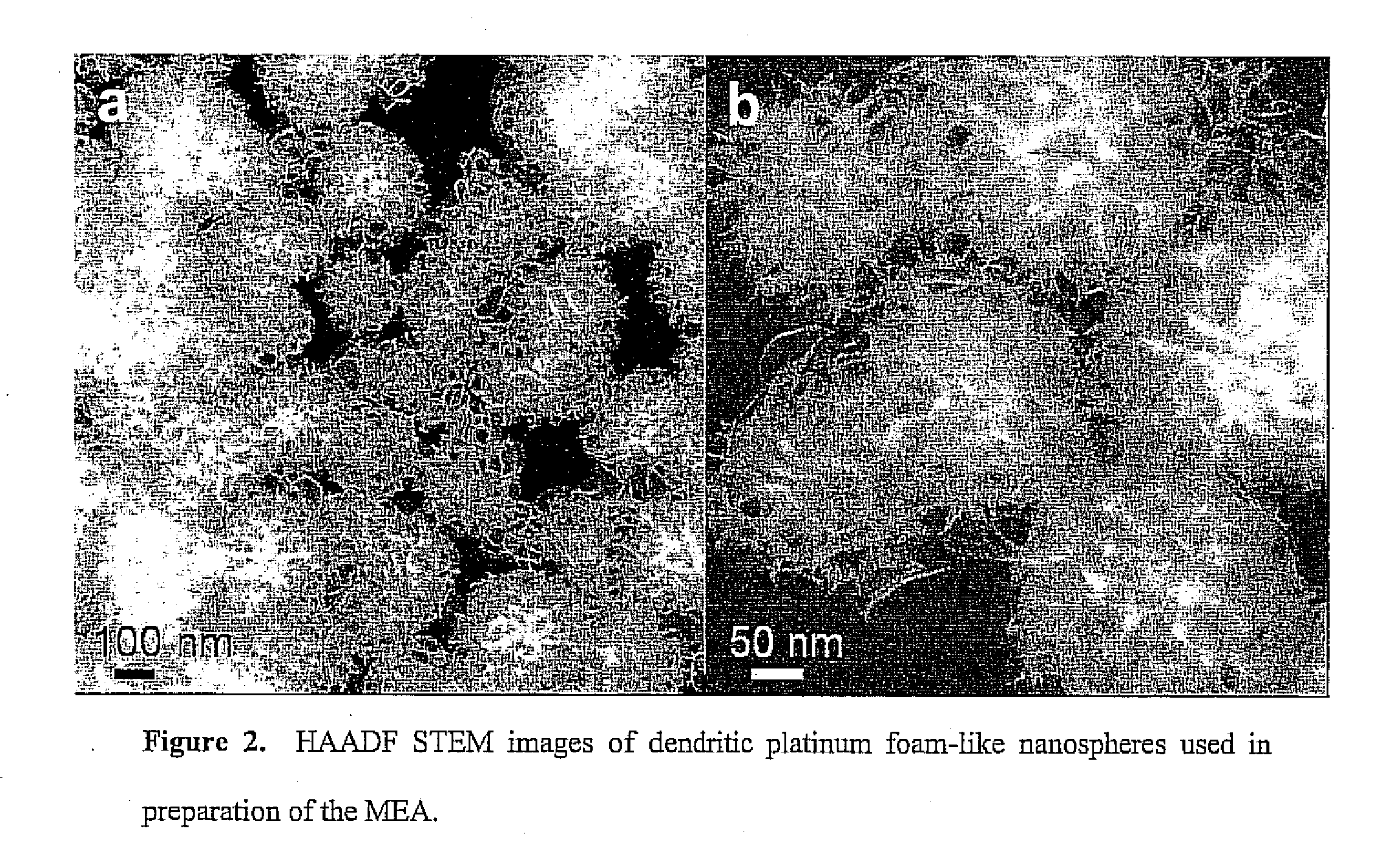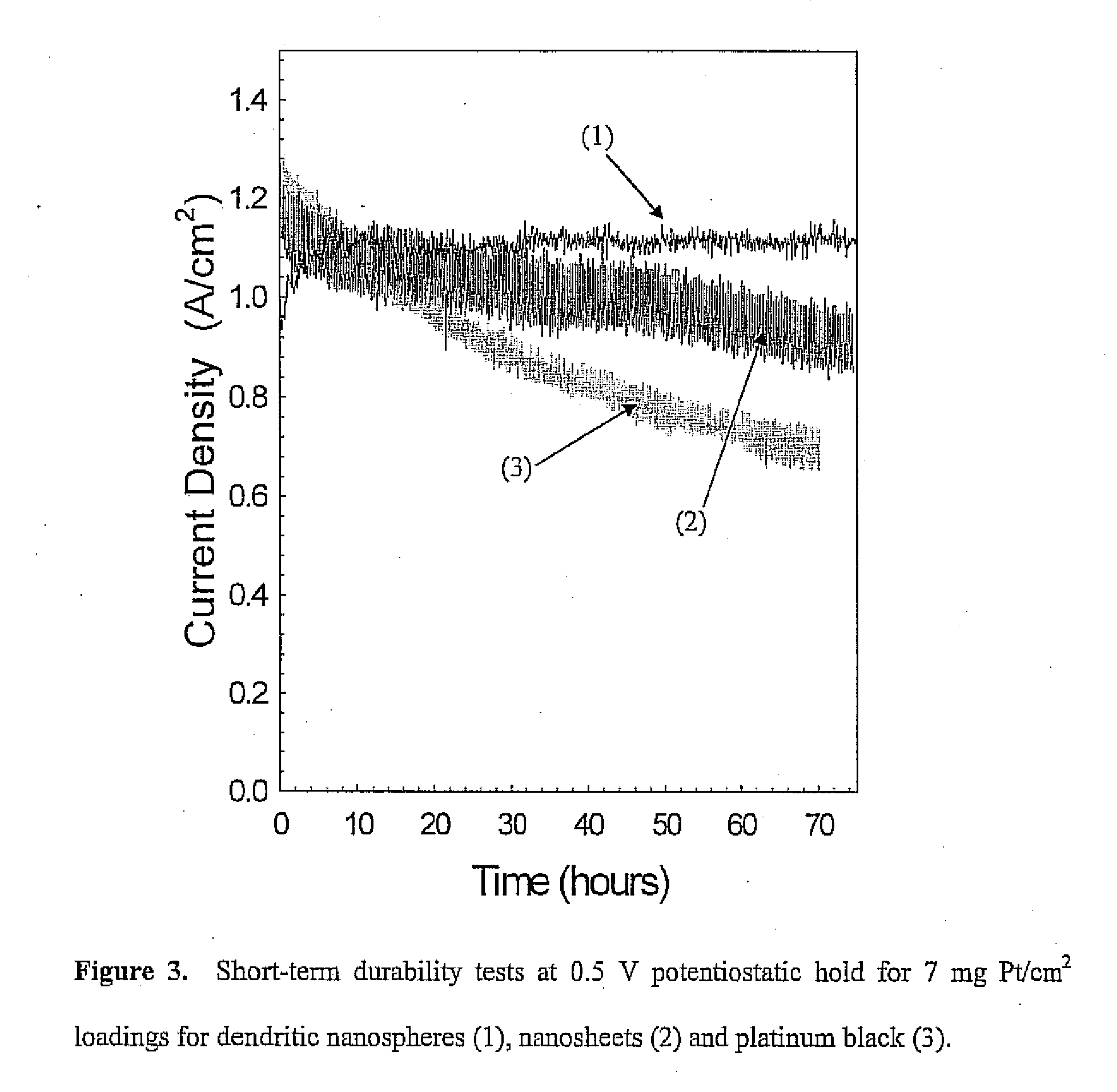Dendritic metal nanostructures for fuel cells and other applications
a metal nanostructure and fuel cell technology, applied in the field of catalysts, can solve the problems of affecting the impact of platinum-based metal materials on the performance and cost of the fuel cell, and the critical hurdles of commercializing current technology,
- Summary
- Abstract
- Description
- Claims
- Application Information
AI Technical Summary
Benefits of technology
Problems solved by technology
Method used
Image
Examples
example 1
Dendritic Platinum Nanosheets
[0057]Multilamellar liposomes (vesicles) were prepared by adding DSPC (1,2-dioctadecanoyl-sn-glycero-3-phosphocholine) (79 mg) to 100 mL of ascorbic acid solution (150 mM) followed by mild sonication for 2 minutes using an ultrasonic cleaner FS14H (Pittsburgh, Pa.). The procedure gives a final DSPC concentration of 1 mM. The average diameter of the vesicles was 400 nm as determined by dynamic light scattering using a Beckman Coulter N5 submicron particle size analyzer. Circular dendritic platinum nanosheets with diameters of 30-500 nm were prepared using the multilamellar DSPC vesicles in ascorbic acid solution (150 mM) as templates. To prepare the dendritic nanosheets, 100 mL of a suspension of the multilamellar DSPC liposomes (1 mM DSPC) in ascorbic acid (150 mM) was mixed with 100 mL of the aged platinum complex (20 mM) in a glass reaction vessel. The reaction mixture was left under ambient conditions for at least 100 minutes to insure that Pt reducti...
example 2
Dendritic Platinum Nanospheres
[0059]Unilamellar liposomes were prepared via an extrusion process. Briefly, 50 mL of the 1.0 mM DSPC and the 1.0-mM cholesterol stock solutions were mixed in a glass tube; lipid films formed on the glass wall after evaporating the chloroform under vacuum. After drying overnight, 100 mL of Nanopure water was added, and the mixture was heated for 1 hour at 65° C. in a water bath. The sample was then vortexed to facilitate the formation of multilamellar vesicles. Finally, the mixture was extruded through a 200 nm porous polycarbonate filter, and the extrusion process was repeated a total of 10 times. The average diameter of the unilamellar liposomes measured by dynamic light scattering was 140-170 nm. Foam-like platinum nanospheres were synthesized by adding 100 mL of the suspension of the unilamellar liposomes prepared in water to a glass reaction vessel, followed by the addition of 100 mL of aged platinum complex (20 mM) and 2.64 g of solid ascorbic aci...
example 3
PEM Fuel Cell Performance of Dendritic Platinum Nanosheets
[0063]The dendritic platinum nanosheets were purified by batch processing of 50 mL quantities of the reaction mixture. The batches were initially centrifuged at 3500 RPM for at least 5 minutes using an EC Centra®MP4R Centrifuge (Golden, Colo.). The supernatant was then removed, certain amount of distillated water added to the black precipitate, and the material re-suspended by mild sonication for 30 minutes. The centrifugation / re-suspension procedure was repeated five additional times to remove as much surfactant, salts and other impurities as possible. The resulting black slurry was then dried in an oven for 12 hours at 75° C. prior to being used in the surface-area and electrocatalysis studies.
[0064]All fuel cell experiments were conducted utilizing 5 cm2 cell hardware and a fuel cell test station from Fuel Cell Technologies (Albuquerque, N.Mex.). The flow fields used were single-channel serpentine in a co-flow anode and ca...
PUM
| Property | Measurement | Unit |
|---|---|---|
| diameter | aaaaa | aaaaa |
| diameter | aaaaa | aaaaa |
| diameter | aaaaa | aaaaa |
Abstract
Description
Claims
Application Information
 Login to View More
Login to View More - R&D
- Intellectual Property
- Life Sciences
- Materials
- Tech Scout
- Unparalleled Data Quality
- Higher Quality Content
- 60% Fewer Hallucinations
Browse by: Latest US Patents, China's latest patents, Technical Efficacy Thesaurus, Application Domain, Technology Topic, Popular Technical Reports.
© 2025 PatSnap. All rights reserved.Legal|Privacy policy|Modern Slavery Act Transparency Statement|Sitemap|About US| Contact US: help@patsnap.com



